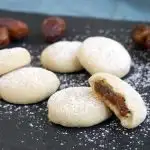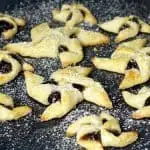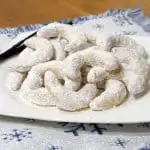Kahk are traditional Eid cookies originating from Egypt. They have a circular shape, a buttery crumb, and can be made plain or with a variety of fillings. Don’t forget to dust the cookies with lots and lots of powdered sugar!
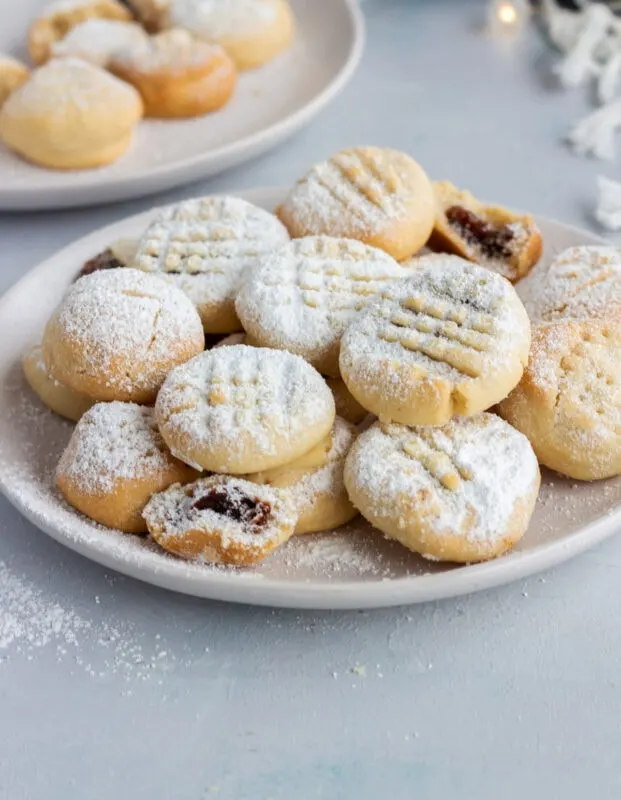
What are Kahk cookies?
Kahk are a type of small round biscuit that originate from Egypt.
They are a traditional cookie that is usually eaten at Eid-ul-Fitr, after the end of Ramadan. In fact, kahk are also called Kahk-al-Eid or cookies of the feast.
They are also served at other celebrations in Egypt such as Easter, Christmas, and at weddings.
Kahk can be made plain, but are usually stuffed with a variety of fillings.
The most common fillings are agameya (a traditional filling made of honey, nuts and ghee), dates, or pistachios.
One of the distinctive features of kahk are the designs on top of the cookies, followed by a dusting of lots of powdered sugar.
What is the history of Kahk?
Kahk is believed to date back to Ancient Egypt, where carvings of people making kahk have been found in the ruins of ancient temples in Memphis and Thebes.
A recipe for kahk was also found in the Great Pyramid of Khufu in Giza.
In ancient Egypt, kahk cookies would be molded into different ornamental and geometrical forms.
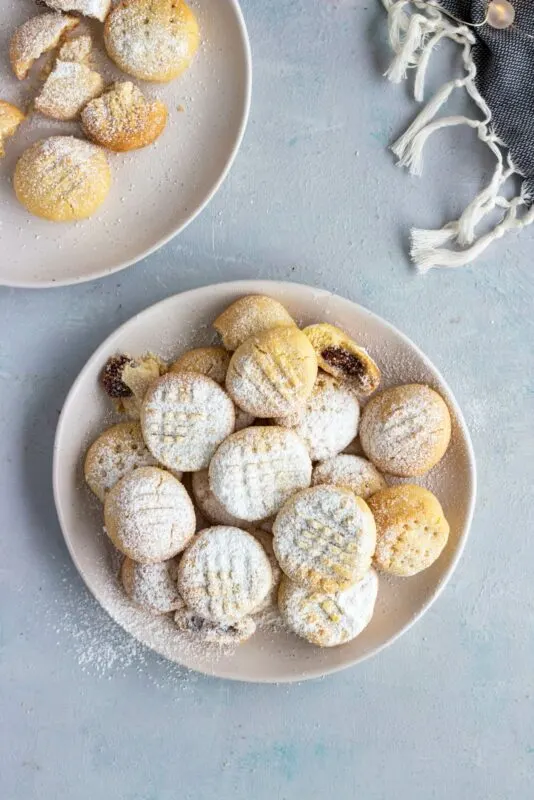
The tradition of making kahk continued over the years and also became a part of Islamic history.
In the Toulunid dynasty, the bakers would make kahk into packets called kul wishkur (“eat and say thank you”). Following that, kahk became prominent among the Ikhshidits, and soon became one of the signature recipes associated with Eid-ul-fitr, the celebration that happens right after the month of Ramadan.
During this Islamic period, the markings on kahk were replaced with geometric designs, sayings, and stylized foliage designs.
The popularity of kahk cookies is such that the making and baking of kahk is a traditional social activity.
Women from a particular neighborhood or village would gather together to make kahk, with every person being assigned specific tasks.
Sometimes, kahk would be prepared at home and taken to a communal bakery to be baked and cooled.
The designs stamped on kahk would also have certain meanings and stories associated with them, with kahk molds passed down from generation to generation in the family.
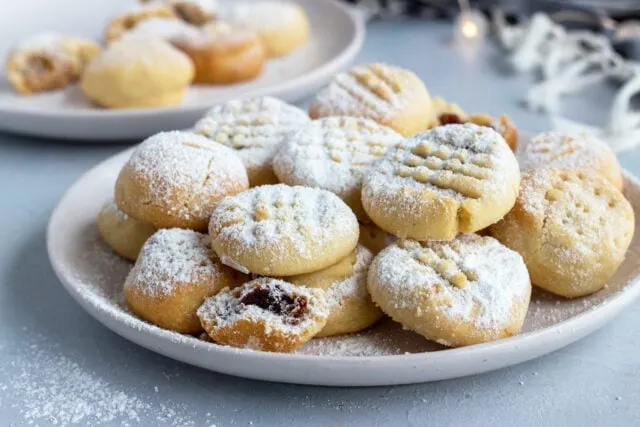
Kahk fillings
Kahk cookies can be made with a variety of fillings, or they can be left plain. The markings on top are usually used to indicate the filling of the kahk cookies.
Some of the most common fillings are:
- Agameya: This is a classic filling made by cooking ghee (clarified butter), honey, sesame seeds, and nuts. Nuts used are usually walnuts, but almonds or pistachios can be used instead. The honey and ghee (clarified butter) are cooked till a soft and sticky, pliable dough is formed. Making agameya requires a lot of care because if it is cooked too much, it will turn hard, but if it is not cooked enough, it will be runny and ooze out of the cookies as they bake.
- Turkish delight: Another common filling for kahk is Turkish delight or malban. It is also known as lokum.
- Agwa / date paste: This sticky sweet date paste is also a popular filling for kahk, and one that I have shared in the recipe below. The date paste can be purchased from Middle Eastern supermarkets or can be made at home.
- Nuts: Kahk can also be filled with different nuts such as walnuts, almonds and pistachios. This can be in the form of whole nuts, or in the form of a nut paste.
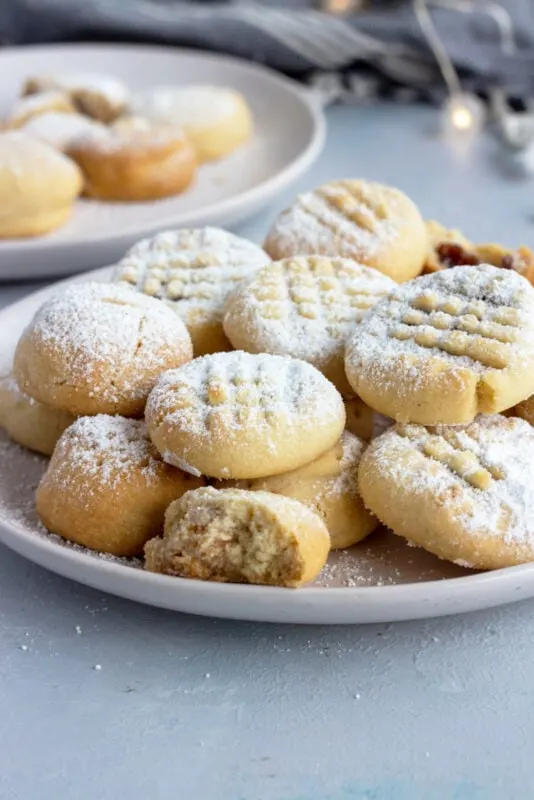
What is Kahk seasoning?
Kahk seasoning is a special blend of powdered spices that is added to kahk cookies to give them their distinctive flavor. It is also known as kahk essence or reehet el kahk and is available at Egyptian stores.
The seasoning differs from family to family, but some of the common ingredients in kahk seasoning are ground mahlab, cardamom, cinnamon, cloves, nutmeg, and fennel.
If you are able to find kahk seasoning, do try it out. Otherwise substitute with your favourite dessert spice or spice blend. In this recipe, I have used cinnamon powder.
Kahk (Egyptian Eid Cookies) -- with Agameya Date paste fillings
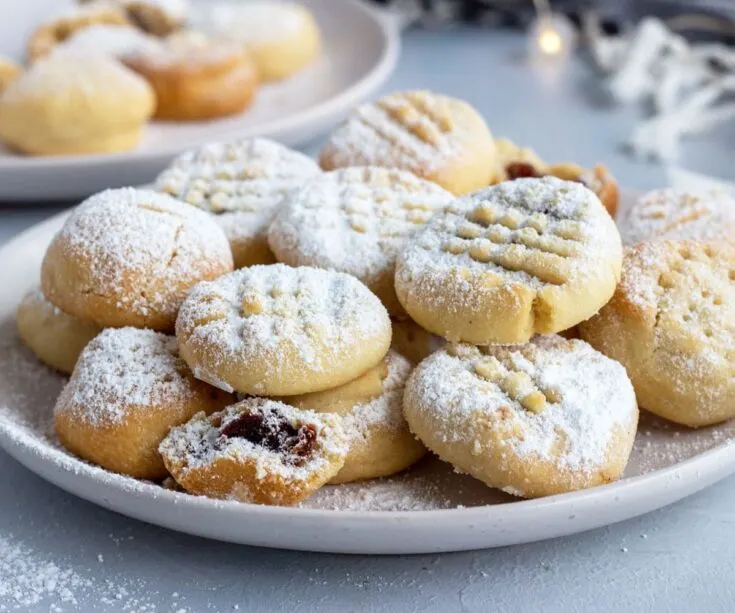
Kahk are traditional Eid cookies originating from Egypt. They have a circular shape, a buttery crumb, and can be made plain or with a variety of fillings. Don’t forget to dust the cookies with lots and lots of powdered sugar!
Ingredients
For the agameya (honey filling) - results in 20 – 24 pieces
- 1 Tablespoon ghee (clarified butter)
- 1/8 cup all-purpose flour
- 6 Tablespoons honey
- ½ Tablespoon sesame seeds, toasted
- 2 Tablespoon finely chopped almonds (or other nut of choice)
For the date (Agwa) filling – results in 20 – 24 pieces
- 120 g (roughly 1/2 cup) pitted Medjool dates (other dates can also be used)
- 1 Tablespoon butter (or ghee)
- 1/2 teaspoon cinnamon powder
For the Kahk dough – results in about 44 – 48 cookies
- ½ kg (4 cups) all purpose flour
- 1 teaspoon baking powder
- 1/8 teaspoon salt
- 1/2 teaspoon cinnamon powder*
- 300 g (1 1/3 cups) ghee (clarified butter)
- 50 g (1/2 cup) powdered sugar / icing sugar, for dusting
- ½ cup milk
Instructions
To make the agameya (honey filling)
- Melt the ghee in a small saucepan over medium-high heat. Add the flour and cook till the mixture turns light golden brown. Make sure to whisk constantly with a small whisk.
- Add honey and bring to a boil. Make sure to stir constantly. Once the mixture comes to a boil, turn heat to low-medium, and cook till the honey starts to thicken. The consistency should be of a thick pourable sauce, but not hardened. If a candy thermometer is available, this is what is called the soft ball stage, 234-240F (112-116C). Remove the saucepan from the heat and add the toasted sesame seeds along with the finely chopped nuts. Stir through, and then transfer the agameya to a small bowl. Let the mixture cool till it is firm, but still soft enough to shape. In the case the mixture hardens too much, warm it in the microwave for a few seconds.
- Grease hands with oil, and then roll the agameya into small teaspoon sized balls. Use a small cookie scoop or teaspoon to help with scooping out the filling. Place the agameya balls on a parchment paper lined tray and keep in the fridge until ready to use.
For the date (agwa) filling
- Place the pitted Medjool dates in a food processor, and pulse until a paste is formed. If a food processor isn’t available, it is possible to chop the dates finely using a sharp knife.
- Place butter in a small saucepan over low heat and let it melt.
- Add the chopped dates along with the cinnamon powder and stir together.
- Stir the dates till a soft paste is formed. If necessary, add ½ - 1 tablespoon of water.
- Once the paste is formed, take the dates out of the saucepan, and let the paste cool.
- Once the date paste is cool, make small teaspoon sized balls of the date mixture. Just like you did with the agameya filling. (Grease your hands with oil if necessary.) Place the date paste balls on a parchment paper lined tray and keep in the fridge until ready to use.
For the Kahk dough
- Place the flour, cinnamon powder, baking powder and salt in a bowl. Mix with a spoon and set aside.
- Place ghee (clarified butter) in a large bowl, and add the powdered sugar / icing sugar. Use an electric beater to whisk together till light and fluffy (about 2 minutes).
- Add the flour mixture to the ghee and sugar. Mix with a wooden spoon until well combined. (The flour will get coated in the ghee / clarified butter and have a crumbly texture.)
- Add the milk and mix again. The dough is ready when it can be formed into a ball and doesn’t crack when pressed. In case the dough hasn’t come together, add another tablespoon of milk or a tablespoon of flour, as required.
- Cover the dough with a cloth, and let it rest it in a cool place or the refrigerator for about 30 minutes.
- Just before you start to roll your cookies, preheat your oven to 180 C (355F) and line two baking sheets with parchment paper.
- Use a tablespoon to scoop out the dough and roll between your palms to form individual balls. The dough balls should be double the size of the filling balls. (It is important to make sure the dough balls are all the same size, so that they bake evenly.)
- To stuff the kahk cookies, place a ball of dough in your hand, and make an indentation using your thumb. Place the filling ball (agameya or date filling) in the center and wrap the remaining dough around it. Roll it into a smooth ball again. The kahk cookies can also be made plain without any filling.
- Make an indentation on the top of the kahk cookies using a fork. (There are special kahk molds available, but basic kitchen utensils can also be used.)
- For agameya cookies – don’t make any indentations as the filling can ooze out if there are cracks on top.
- Place the prepared kahk cookies on a baking sheet lined with parchment paper. Make sure there is space between each cookie.
- Bake in a pre-heated oven on 180 C (355F) for about 15 – 18 minutes until the bottom is browned, and the top is pale golden. The filled cookies will bake more quickly than the plain ones.
- Remove from the oven and let the cookies cool for a few minutes on the baking sheet. Then move to a wire rack to finish cooling.
- When the cookies have cooled, place them on a platter and dust generously with powdered sugar. This step is particularly important. The cookies aren’t too sweet, and the powdered sugar not only looks beautiful, but also adds sweetness to the cookies.
Notes
*Kahk seasoning is a special blend of powdered spices that is added to kahk cookies to give them their distinctive flavor. It is also known as kahk essence or reehet el kahk and is available at Egyptian stores. Some of the common ingredients in kahk seasoning are ground mahlab, cardamom, cinnamon, cloves, nutmeg, and fennel. If you are able to find kahk seasoning, do try it out. Otherwise substitute with your favourite dessert spice or spice blend or simply use cinnamon, like we did in this recipe.
Nutrition Information:
Yield:
22Serving Size:
2 cookiesAmount Per Serving: Calories: 469Total Fat: 2g
If you liked this recipe, here are some similar dishes you may enjoy!

Kiran is originally from Pakistan, and is a food blogger and recipe developer. One of the things that she loves doing is learning about different cuisines and learning how food has shaped culture and history around the world. You can find Kiran on her blog MirchiTales.com as well as on Instagram.
